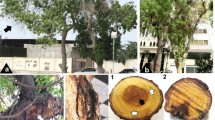Abstract
BARK cracking accompanied by the exudation of latex (Fig. 1) in young trees of certain clones of Hevea brasiliensis Mull.–Arg. has been observed in the Eastern rubber-growing countries for a number of years1. The symptoms of this disorder and the accompanying histological abnormalities have been described recently2. This is a brief note on the aetiology of the disease.
Similar content being viewed by others
References
Bobilioff, W., Arch. Voor Rubbercultuur, 56, 215 (1930).
Peries, O. S., and Satchuthananthavale, R., Trop. Agric., 41, 265 (1964).
Moorhead Ball. Ellen, Serological Tests for the Identification of Plant Viruses (American Phytopathological Society, 1961).
Riggenbach, A., Quart. Circ. Rubb. Res. Inst. Ceylon, 32, 65 (1957).
Taysum, D. H., Proceedings of the Natural Rubber Research Conference, Kuala Lumpur, 1960, 858 (Rubber Research Institute of Malaya, 1961).
Author information
Authors and Affiliations
Rights and permissions
About this article
Cite this article
PERIES, O., BROHIER, Y. A Virus as the Causal Agent of Bark Cracking in Hevea brasiliensis. Nature 205, 624–625 (1965). https://doi.org/10.1038/205624a0
Issue Date:
DOI: https://doi.org/10.1038/205624a0
- Springer Nature Limited
This article is cited by
-
Some virus and virus-like diseases of tobacco, tomato, papaya, and rubber tree in vietnam and cambodia
Biologia Plantarum (1976)





